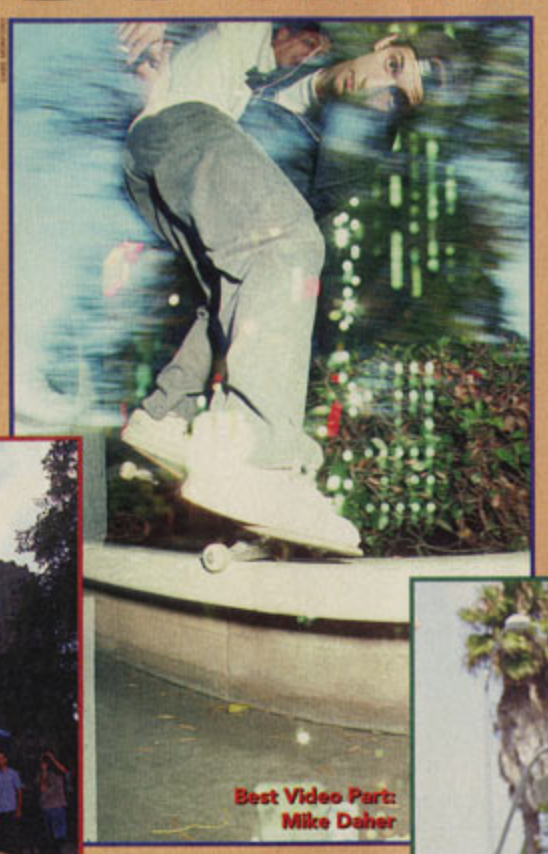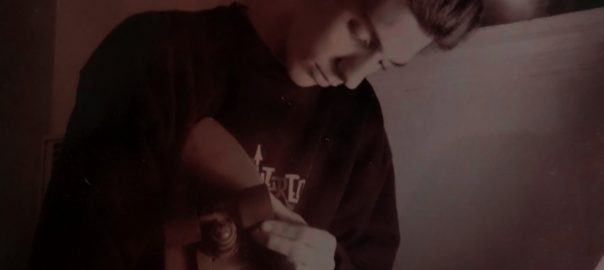While 1990 may have been the year that street style skateboarding eclipsed vert in progression and relevance, and 1992 may have seen boards gets symmetrical while tricks got big and dangerous, but, by my analysis, 1994 was the year it all came together. Raw East Coast skating started to get is proper documentation with Dan Wolfe’s Eastern Exposure 2 and Sub Zero videos. Over in Southern California, heavy skate parts like Kris Markovich in Prime’s Fight Fire With Fire and new-to-Plan B Jeremy Wray in Second Hand Smoke added significant nails to the slow-rolling-prayer-flip-to-curb-grind-combo coffin. But arguably the video that made the biggest impact in skateboarding during that significant year was Stereo’s A Visual Sound.

Stereo Skateboards was started by Jason Lee and Chris ‘Dune’ Pastras (aged 21 and 19 at the time) in 1992 out of DLX Distribution in San Francisco after a false-start partnership with Vision’s Brad Dorfman called Blue. It was built around vintage Americana design principles, particularly that of Blue Note-era jazz record aesthetics and icons. In an era of acceptable sloppiness in the name of advancing technical progression, not to mention questionable fashion choices and visual branding centered around cartoons and sarcasm, Stereo stood out by doing less. This emphasis on simplicity was evident in the graphics and advertisements, and then really hit home when they released A Visual Sound.
The video is a testament to the strength of a unified aesthetic. While a specific rider’s persona might get muted for the over-arching image of the brand (Did Mike Frazier really hand out in coffee shops? Would Carl Shipman prefer brighter colored footage? Was Greg Hunt actually into jazz music?), having Dune and Jason (and probably Tobin Yelland) art direct the project and execute their vision alone makes A Visual Sound about as cohesive a video as can be.
But it isn’t just the jazz soundtrack and the still photos and the black and white super8 film. The Stereo team all understood the importance of style and simplicity. The pants are tighter, the tricks are much simpler, and the obstacles are higher. Everyone seems relaxed and flowing. While any review of the component parts of A Visual Sound needs to spend time paying homage to the complete video (as we have just done), and Ethan Fowler, Matt Rodriguez, and Jason Lee all produced exemplary sections that are worthy of praise, the skaterboarding part I want to watch again and again is the video opener: Mike Daher.
Originally from New Jersey and coming up in Florida with the first wave of Alien guys, Daher spent a little bit of time on Powell before getting drafted into early Stereo. His part is preluded with 30 seconds of super8 film and still photographs that portray Mike arriving, lighting a cigarette, throwing down his board, and then we’re off. It’s a great setup to a part that just oozes accessible San Francisco street skating. Most of ‘the city’s’ pre-Pier 7 compulsory spots are here (Brown Marble, Union Square, both sides of Wallenberg school, Ft. Miley), but none of the moves are pushing the limits of courage nor technical innovation.
The strength of this part is simplicity, pop, and style. The wheelies are smooth, the ollies are big, the ledges are significantly well over curb height, and the pants are reasonable sized. The colors are subdued and mellow. The jazz music percolates rather than pushes.
One would think a part this simple and flow-y would easily be overlooked when released, only to be rediscovered by overenthusiastic skate bloggers 25 years later. But, surprisingly, it was well regarded for it’s time. Thrasher magazine, the home of ‘skate and destroy’, even declared it “Best Video Part” in their 1995 T-Eddy awards.

As Jason Lee transitioned from skateboarder to Mallrat movie star, Mike Daher found himself more or less ‘over it‘ when it came to skateboarding for dollars. He popped up here and there every 7 or so years later, filming a trick here for Supernaut and there for Rasa Libre, but more or less this one part is his entire legacy to skateboarding. From what I can gather, after dropping off of Stereo Mike was an early adopter of growing and supplying herbs for the California medical marijuana movement with his Rolling Hills Farm brand. He had a guest board from Magenta and Killing Floor in 2015, and more recently a Strangelove guest board referenced his present horticulture career.
Bonus Daher:
A few fun facts:
- Mike’s older brother George invented the concept of ‘focusing’ (intentionally breaking with a definitive stomp) one’s board. He also coined the term.
- Mike was initially to be part of Metal Skateboards along with Freddy Gall and Jerry Fisher, but he didn’t stick with it through its initial roadblocks.
Bonus Bonus Daher:
Cruise over to 4ply Magazine where we have dissected Mike Daher’s Stereo part and transmuted the data it into a bunch of diagrams and visualizations for a new feature we call Crushing Numbers. If you like soulful video parts reduced to a couple of bar charts, you’re stoked.

Bonus Bonus Bonus Daher:
And here is Mike skating to the Grateful Dead in a very low-res upload of Rasa Libre‘s 2008 video, A Cosmic Experience:
Bonus Bonus Bonus Bonus Daher:
I figured out how to remove the music from this part, so here is Mike Daher in A Visual Sound with only skate sound.
Featured image at top of post is by Chris Pastras.
